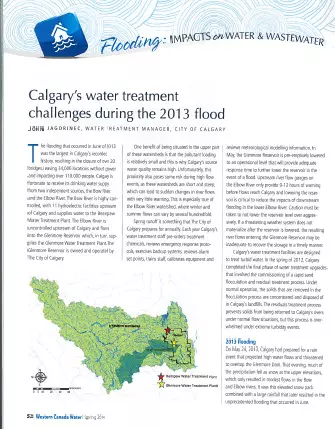Calgary's Water Treatment Challenges During the 2013 Flood
The flooding that occurred in June of 2013 was the largest in Calgary's recorded history, resulting in the closure over 20 bridges, leaving 34,000 locations without power and impacting over 110,000 people. Calgary is fortunate to receive its drinking water supply from two independent sources, the Bow River and the Elbow River. The Bow River is highly controlled, with 11 hydroelectric facilities upstream of Calgary and supplies water to the Bearspaw Water Treatment Plant. The Elbow River is uncontrolled upstream of Calgary and flows into the Glenmore Reservoir which, in turn, supplies the Glenmore Water Treatment Plant. The Glenmore Reservoir is owned and operated by The City of Calgary.
One benefit of being situated in the upper part of these watersheds is that the pollutant loading is relatively small and this is why Calgary's source water quality remains high. Unfortunately, this proximity also poses some risk during high flow events, as these watersheds are short and steep, which can lead to sudden changes in river flows with very little warning. This is especially true of the Elbow River watershed, where winter and summer flows can vary by several hundredfold.
Spring runoff is something that The City of Calgary prepares for annually. Each year Calgary's water treatment staff pre-orders treatment chemicals, reviews emergency response protocols, exercises backup systems, reviews alarm set points, trains staff, calibrates equipment and reviews meteorological modelling information. In May, the Glenmore Reservoir is pre-emptively lowered to an operational level that will provide adequate response time to further lower the reservoir in the event of a flood. Upstream river flow gauges on the Elbow River only provide 9-12 hours of warning before flows reach Calgary and lowering the reservoir is critical to reduce the impacts of downstream flooding in the lower Elbow River. Caution must be taken to not lower the reservoir level over aggressively. If a threatening weather system does not materialize after the reservoir is lowered, the resulting river flows entering the Glenmore Reservoir may be inadequate to recover the storage in a timely manner.
Calgary's water treatment facilities are designed to treat turbid water. In the spring of 2012, Calgary completed the final phase of water treatment upgrades that involved the commissioning of a rapid sand flocculation and residual treatment process. Under normal operation, the solids that are removed in the flocculation process are concentrated and disposed of in Calgary's landfills. The residuals treatment process prevents solids from being returned to Calgary's rivers under normal flow situations, but this process is overwhelmed under extreme turbidity events.
2013 Flooding
On May 24, 2013, Calgary had prepared for a rain event that projected high water flows and threatened to overtop the Glenmore Dam. That evening, much of the precipitation fell as snow at the upper elevations, which only resulted in modest flows in the Bow and Elbow rivers. It was this elevated snow pack combined with a large rainfall that later resulted in the unprecedented flooding that occurred in June.
On the morning of Thursday June 20, the water treatment plants were anxiously awaiting high river flows to reach Calgary. Seven hours prior to this, online flow monitoring devices upstream of Calgary reported an extremely sharp increase in river flow. This seemed to support the precipitation and temperature data that were collected, as it had rained hard all night and air temperatures in the upper watershed were about 5° C at 2100m elevation. It appeared that it was raining on the snow pack. The Glenmore Reservoir was now at its target flood elevation and the treated water that was stored in the distribution system was at its maximum level.
The decision was made to bypass the residuals process waste streams to our rivers prior to reaching peak raw water turbidities. Water Treatment staff recognized that this process would become overwhelmed during the flood and bypassing the waste streams to the rivers would allow them to focus their efforts exclusively on treating drinking water. This later proved to be an important decision, as the treatment processes were extremely challenged. By 08:00 hrs on June 20, both treatment plants were starting to see rapid changes to source water quality and a local state of emergency was declared later that morning.
In the afternoon of June 20, Elbow River flows entering the Glenmore Reservoir surpassed the maximum discharge rates and the reservoir began to fill. Within 7.5 hours, the water overtopped the Glenmore Dam and the high flows had consumed all of the 10,000,000 m3 of available storage.
It only took an additional eight hours for the Glenmore Reservoir to reach its peak elevation of 2.2m above crest and at one point the Glenmore Reservoir was filling at a rate of over 3 cm per minute. The Bow River was also observing peak turbidity, total organic carbon (TOC) and river flows. Historically, the Elbow and Bow River watersheds do not peak at the same time, allowing Calgary to adjust production between the treatment plants to take advantage of the better source water quality.

Treatment Challenges
Both water treatment plants were extremely challenged during the 2013 flood event, but the Glenmore Water Treatment Plant was particularly taxed. Raw water turbidity meters were overwhelmed as the turbidities rose above their 4000 NTU operational limit and source water TOC concentrations exceeded 2 5 mg/L. Prior to 2013, the highest recorded source water turbidities occurred in 2005, where turbidities and total organic carbon (TOC) concentrations peaked at 1500 NTU and 11. 5 mg/L respectively. The Bow River flows through Calgary reached 1: 100 year returns, but the flow on the Elbow River entering the Glenmore Reservoir was much higher.
Fortunately, the flow profile for the flood on the Elbow River showed a sharp increase in flow followed by a sharp decrease. This allowed the Glenmore Reservoir to attenuate a significant portion of the peak flow. The Elbow River flows entering the Glenmore Reservoir peaked at 1240 m3/s (1:500 yr return), but downstream discharges were held to 700 m3/s ( 1: 100 year return).
On June 21, water treatment staff observed deteriorating filter recoveries times at the Glenmore Water Treatment Plant after backwashing. High TOC concentrations combined with plant optimization challenges were likely the cause, even though the ballasted flocculation process was working very well. The ballasted flocculation process discharges clarified water into a 34 ML water basin that feeds the filters. The decision was made to drain the clarified water basin to allow water treatment staff to re-optimize the blasted flocculation process and add a filter aid polymer to the treatment process. Watering restrictions were implemented to reduce system demand and allow the Glenmore Water Treatment Plant to be taken offline for approximately 20 hours. It was uncertain how long it would take to recover the distribution system storage once the Glenmore Water Treatment Plant was producing water again, as the production would likely continue to be impacted by source water quality.
During this period, the Bearspaw Water Treatment Plant and system storage had to meet Calgary's water demand. Production leaving the Bearspaw plant did not increase during this time because the plant appeared to be optimized and a plant upset would have had severe production impacts. Water treatment staff was able to recover the Glenmore treatment process. Apart from a turbidity spike that occurred for a few hours after the plant began producing water again, water quality leaving the plant remained relatively unchanged.
Water treatment chemical use increased significantly during the flood. A particular concern was the amount of micro-sand that was being consumed at the Bearspaw Water Treatment Plant. Normally the flocculation process recycles 95% of its sand, but the source water turbidity had impacted the recycle efficiency. If the flood event was to continue for an extended time, the sand supply may have become critically low. Calgary was able to secure additional sand from The City of Red Deer, which was extremely helpful in expediting the shipment.

Successes
Through the entire flood event, Calgary continued to produce high quality drinking water and remained compliant with Provincial regulation. This was an amazing achievement as many communities around Calgary were forced to boil water. This was only possible because of the technological upgrades that were in place and the amazing adaptability of Calgary's water treatment and support staff.
The 2013 flood damage sustained to city infrastructure was significant. The damage to the downtown area and lower Elbow River would have been considerably worse had the Glenmore Reservoir not been able to successfully attenuate much of the peak flows. Flood modelling and weather forecasting played a major role in managing the Glenmore Reservoir.
Prior to the flooding in 2013, Calgary's knowledge of flooding stemmed from the flood in 2005. The 2005 flood was considerably smaller and Calgary had not seen any significant flood events since the first treatment plant was commissioned in 1933. Knowledge gained from the flood of 2013 was invaluable in addressing future floods of this magnitude and provided an opportunity to better understand the limitations of various water treatment plant processes.
Originally published in Western Canada Water, Spring 2014, written by John Jagorinec, Water Treatment Manager, City of Calgary.



